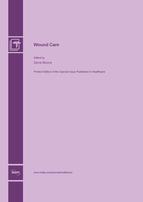Wound Care
A special issue of Healthcare (ISSN 2227-9032).
Deadline for manuscript submissions: closed (30 April 2015) | Viewed by 159182
Special Issue Editor
Interests: wound healing and tissue repair; pressure ulcer prevention and management; quantitative research methods; design, conduct and analysis of clinical trials; epidemiology; clinical nurse specialists; evidence based practice; research implementation; systematic reviews; quality of life; health economics
Special Issue Information
Dear Colleagues,
Wounds and the many associated problems have challenged health care providers for centuries and today, despite the wealth of knowledge available, neither the incidence nor prevalence of wounds is reducing. Furthermore, in view of our changing demographic profile and the projected increase in the older population, it is likely that wound management will become an ever increasing burden to the individual, health care services and society as a whole. The annual incidence of wounds in the EU-27 is approximately 4 million, and between 25% and 50% of acute hospital beds are occupied by patients with a wound, with up to 60% of these representing non-healing wounds (infected surgical wounds, pressure ulcers, leg/foot ulcers) The increasing prevalence and incidence of non-wounds healing is closely linked with quality of care and, as such, these rising figures reduce society’s confidence in the health service’s ability to deliver care that is timely, appropriate and effective. Thus, for those involved in this specialist area of clinical practice, the fundamental goal is to improve clinical outcomes, reduce the burden of wounds and improve health related quality of life.
Prof. Zena Moore
Guest Editor
Manuscript Submission Information
Manuscripts should be submitted online at www.mdpi.com by registering and logging in to this website. Once you are registered, click here to go to the submission form. Manuscripts can be submitted until the deadline. All submissions that pass pre-check are peer-reviewed. Accepted papers will be published continuously in the journal (as soon as accepted) and will be listed together on the special issue website. Research articles, review articles as well as short communications are invited. For planned papers, a title and short abstract (about 100 words) can be sent to the Editorial Office for announcement on this website.
Submitted manuscripts should not have been published previously, nor be under consideration for publication elsewhere (except conference proceedings papers). All manuscripts are thoroughly refereed through a single-blind peer-review process. A guide for authors and other relevant information for submission of manuscripts is available on the Instructions for Authors page. Healthcare is an international peer-reviewed open access semimonthly journal published by MDPI.
Please visit the Instructions for Authors page before submitting a manuscript. The Article Processing Charge (APC) for publication in this open access journal is 2700 CHF (Swiss Francs). Submitted papers should be well formatted and use good English. Authors may use MDPI's English editing service prior to publication or during author revisions.
Keywords
- wound care
- pressure ulcer
- diabetic foot ulcer
- leg ulcer
- non-healing wound
- health related quality of life
- cost effectiveness







